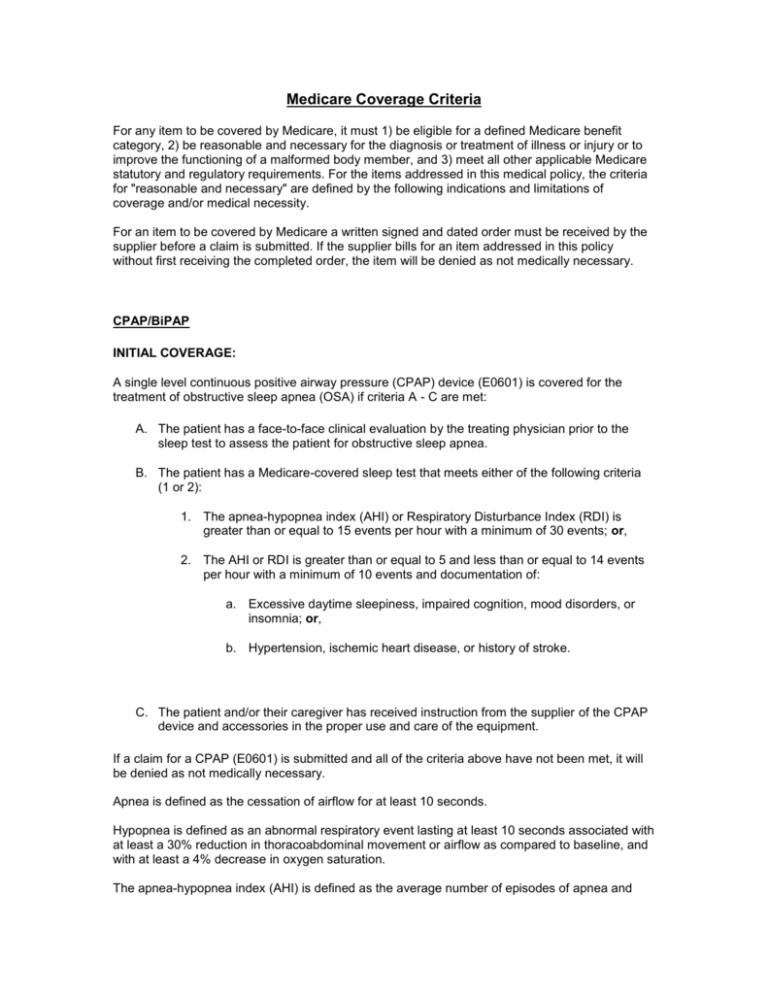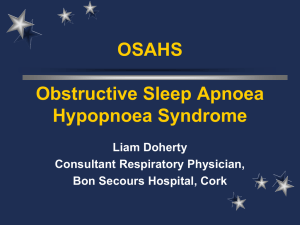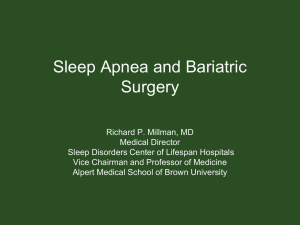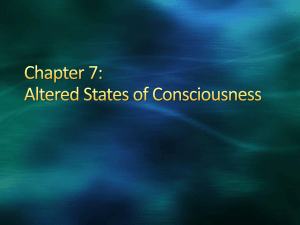Medicare Coverage Criteria
advertisement

Medicare Coverage Criteria For any item to be covered by Medicare, it must 1) be eligible for a defined Medicare benefit category, 2) be reasonable and necessary for the diagnosis or treatment of illness or injury or to improve the functioning of a malformed body member, and 3) meet all other applicable Medicare statutory and regulatory requirements. For the items addressed in this medical policy, the criteria for "reasonable and necessary" are defined by the following indications and limitations of coverage and/or medical necessity. For an item to be covered by Medicare a written signed and dated order must be received by the supplier before a claim is submitted. If the supplier bills for an item addressed in this policy without first receiving the completed order, the item will be denied as not medically necessary. CPAP/BiPAP INITIAL COVERAGE: A single level continuous positive airway pressure (CPAP) device (E0601) is covered for the treatment of obstructive sleep apnea (OSA) if criteria A - C are met: A. The patient has a face-to-face clinical evaluation by the treating physician prior to the sleep test to assess the patient for obstructive sleep apnea. B. The patient has a Medicare-covered sleep test that meets either of the following criteria (1 or 2): 1. The apnea-hypopnea index (AHI) or Respiratory Disturbance Index (RDI) is greater than or equal to 15 events per hour with a minimum of 30 events; or, 2. The AHI or RDI is greater than or equal to 5 and less than or equal to 14 events per hour with a minimum of 10 events and documentation of: a. Excessive daytime sleepiness, impaired cognition, mood disorders, or insomnia; or, b. Hypertension, ischemic heart disease, or history of stroke. C. The patient and/or their caregiver has received instruction from the supplier of the CPAP device and accessories in the proper use and care of the equipment. If a claim for a CPAP (E0601) is submitted and all of the criteria above have not been met, it will be denied as not medically necessary. Apnea is defined as the cessation of airflow for at least 10 seconds. Hypopnea is defined as an abnormal respiratory event lasting at least 10 seconds associated with at least a 30% reduction in thoracoabdominal movement or airflow as compared to baseline, and with at least a 4% decrease in oxygen saturation. The apnea-hypopnea index (AHI) is defined as the average number of episodes of apnea and hypopnea per hour of sleep without the use of a positive airway pressure device. The respiratory disturbance index (RDI) is defined as the average number of apneas plus hypopneas per hour of recording without the use of a positive airway pressure device. If the AHI or RDI is calculated based on less than 2 hours of sleep or recording time, the total number of recorded events used to calculate the AHI or RDI (respectively) must be at least the number of events that would have been required in a 2 hour period (i.e., must reach ≥30 events without symptoms or ≥10 events with symptoms). Respiratory Assist Devices (RAD) A RAD without backup rate (E0470) is covered for those patients with OSA who meet criteria A-C above, in addition to criterion D: D. A single level (E0601) positive airway pressure device has been tried and proven ineffective based on a therapeutic trial conducted in either a facility or in a home setting. If E0470 is billed and criterion D is not met, payment will be based on the allowance for the least costly medically appropriate alternative, E0601. A RAD with backup rate (E0471) is not medically necessary if the primary diagnosis is OSA; therefore, if E0471 is billed with a diagnosis of OSA, the following payment rules apply: 1. If criteria A - D above are met, payment will be based on the allowance for the least costly medically appropriate alternative, E0470; or, 2. If criteria A-C above are met but not criterion D, payment will be based on the allowance for the least costly medically appropriate alternative, E0601. If a CPAP device is tried and found ineffective during the initial 3 month home trial, substitution of a RAD does not require a new initial face-to-face clinical evaluation or a new sleep test. If a CPAP device has been used for more that 3 months and the patient is switched to a RAD, a new initial face-to-face clinical evaluation is required, but a new sleep test is not required. A new 3 month trial would begin for use of the RAD. Coverage, coding and documentation requirements for the use of RADs for diagnoses other than OSA are addressed in the RAD policy. Sleep Tests Coverage and Payment rules for sleep tests may be found in the local coverage determinations (LCDs) for the applicable Medicare Part A or Part B contractor. There may be differences between those LCDs and the DME MAC LCD. For the purposes of coverage of PAP therapy, the DME MAC coverage, coding and payment rules take precedence. Coverage of a PAP device for the treatment of OSA is limited to claims where the diagnosis of OSA is based upon a Medicare-covered sleep test (Type I, II, III, IV). A Medicare-covered sleep test must be either a polysomnogram performed in a facility-based laboratory (Type I study) or a home sleep test (HST) (Types II, III, or IV). The test must be ordered by the beneficiary’s treating physician and conducted by an entity that qualifies as a Medicare provider of sleep tests and is in compliance with all applicable state regulatory requirements. A Type I sleep test is the continuous and simultaneous monitoring and recording of various physiological and pathophysiological parameters of sleep with physician review, interpretation, and report. It is facility-based and must include sleep staging, which is defined to include a 1-4 lead electroencephalogram (EEG), electro-oculogram (EOG), submental electromyogram (EMG) and electrocardiogram (ECG). It must also include at least the following additional parameters of sleep: airflow, respiratory effort, and oxygen saturation by oximetry. It may be performed as either a whole night study for diagnosis only or as a split night study to diagnose and initially evaluate treatment. An HST is performed unattended in the beneficiary’s home using a portable monitoring device. A portable monitoring device for conducting an HST must meet one of the following criteria: A. Type II device – Monitors and records a minimum of seven (7) channels: EEG, EOG, EMG, ECG/heart rate, airflow, respiratory movement/effort and oxygen saturation; or, B. Type III device – Monitors and records a minimum of four (4) channels: respiratory movement/effort, airflow, ECG/heart rate and oxygen saturation; or, C. Type IV device – Monitors and records a minimum of three (3) channels that allow direct calculation of an AHI or RDI as the result of measuring airflow or thoracoabdominal movement. Devices that record information other than airflow or thoracoabdominal movement that allow calculation of an AHI or RDI may be considered as acceptable alternatives if there is substantive clinical evidence in the published peer-reviewed medical literature that demonstrates that the results accurately and reliably correspond to an AHI or RDI as defined above. This determination will be made on a device by device basis (See Appendix B for list of approved Type IV devices that do not report AHI/RDI based on direct measurement of airflow or thoracoabdominal movement). For PAP devices with initial dates of service on or after November 1, 2008, all beneficiaries who undergo an HST must, prior to having the test, receive instruction on how to properly apply a portable sleep monitoring device. This instruction must be provided by the entity conducting the HST and may not be performed by a DME supplier. Patient instruction may be accomplished by either: 1. Face-to-face demonstration of the portable sleep monitoring device’s application and use; or, 2. Video or telephonic instruction, with 24 hour availability of qualified personnel to answer questions or troubleshoot issues with the device. For PAP devices with initial dates of service on or after November 1, 2008, all HSTs (Type II, III, or IV) must be interpreted by a physician who holds either: 1. Current certification in Sleep Medicine by the American Board of Sleep Medicine (ABSM); or, 2. Current subspecialty certification in Sleep Medicine by a member board of the American Board of Medical Specialties (ABMS); or, 3. Completed residency or fellowship training by an ABMS member board and has completed all the requirements for subspecialty certification in sleep medicine except the examination itself and only until the time of reporting of the first examination for which the physician is eligible; or, 4. Active staff membership of a sleep center or laboratory accredited by the American Academy of Sleep Medicine (AASM) or The Joint Commission (formerly the Joint Commission on Accreditation of Healthcare Organizations – JCAHO). For PAP devices with initial dates of service on or after January 1, 2010, physicians interpreting facility-based polysomnograms (Type I) must meet one of the requirements listed above (1-4) for credentialing. No aspect of an HST, including but not limited to delivery and/or pickup of the device, may be performed by a DME supplier. This prohibition does not extend to the results of studies conducted by hospitals certified to do such tests. CONTINUED COVERAGE BEYOND THE FIRST THREE MONTHS OF THERAPY: Continued coverage of a PAP device (E0470 or E0601) beyond the first three months of therapy requires that, no sooner than the 31st day but no later than the 91st day after initiating therapy, the treating physician must conduct a clinical re-evaluation and document that the beneficiary is benefiting from PAP therapy. For PAP devices with initial dates of service on or after November 1, 2008, documentation of clinical benefit is demonstrated by: 1. Face-to-face clinical re-evaluation by the treating physician with documentation that symptoms of obstructive sleep apnea are improved; and, 2. Objective evidence of adherence to use of the PAP device, reviewed by the treating physician. Adherence to therapy is defined as use of PAP ≥4 hours per night on 70% of nights during a consecutive thirty (30) day period anytime during the first three (3) months of initial usage. If the above criteria are not met, continued coverage of a PAP device and related accessories will be denied as not medically necessary. Beneficiaries who fail the initial 12 week trial are eligible to requalify for a PAP device but must have both: 1. Face-to-face clinical re-evaluation by the treating physician to determine the etiology of the failure to respond to PAP therapy; and, 2. Repeat sleep test in a facility-based setting (Type 1 study). If the physician re-evaluation does not occur until after the 91st day but the evaluation demonstrates that the patient is benefiting from PAP therapy as defined in criteria 1 and 2 above, continued coverage of the PAP device will commence with the date of that re-evaluation. If a CPAP device is tried and found ineffective during the initial 3 month home trial, substitution of a RAD (E0470) does not change the length of the trial unless there is less than 30 days remaining in the trial period. If more than 30 days remain in the trial period, the clinical reevaluation would still occur between the 31st and 91st day following the initiation of CPAP. If less than 30 days remain in the trial period, the clinical re-evaluation must occur before the 120th day following the initiation of CPAP. If a CPAP device was used for more that 3 months and the patient was switched to a RAD, then the clinical re-evaluation would occur between the 31st and 91st day following the initiation of the RAD. There would also need to be documentation of adherence to therapy during the 3 month trial with the RAD. If there is discontinuation of usage of a PAP device at any time, the supplier is expected to ascertain this and stop billing for the equipment and related accessories and supplies. For a PAP device dispensed prior to November 1, 2008, if the initial Medicare coverage criteria in effect at the time were met and the criteria for coverage after the first 3 months that were in effect at the time were met, the device will continue to be covered for dates of service on or after November 1, 2008 as long as the patient continues to use the device. BENEFICIARIES ENTERING MEDICARE: For beneficiaries who received a PAP device prior to enrollment in fee for service (FFS) Medicare and are seeking Medicare coverage of either a replacement PAP device and/or accessories, both of the following coverage requirements must be met: 1. Sleep test – There must be documentation that the beneficiary had a sleep test, prior to FFS Medicare enrollment, that meets the Medicare AHI/RDI coverage criteria in effect at the time that the beneficiary seeks a replacement PAP device and/or accessories; and, 2. Clinical Evaluation – Following enrollment in FFS Medicare, the beneficiary must have a face-to-face evaluation by their treating physician who documents in the beneficiary’s medical record that: a. The beneficiary has a diagnosis of obstructive sleep apnea; and, b. The beneficiary continues to use the PAP device. If either criteria 1 or 2 above are not met, the claim will be denied as not medically necessary.





